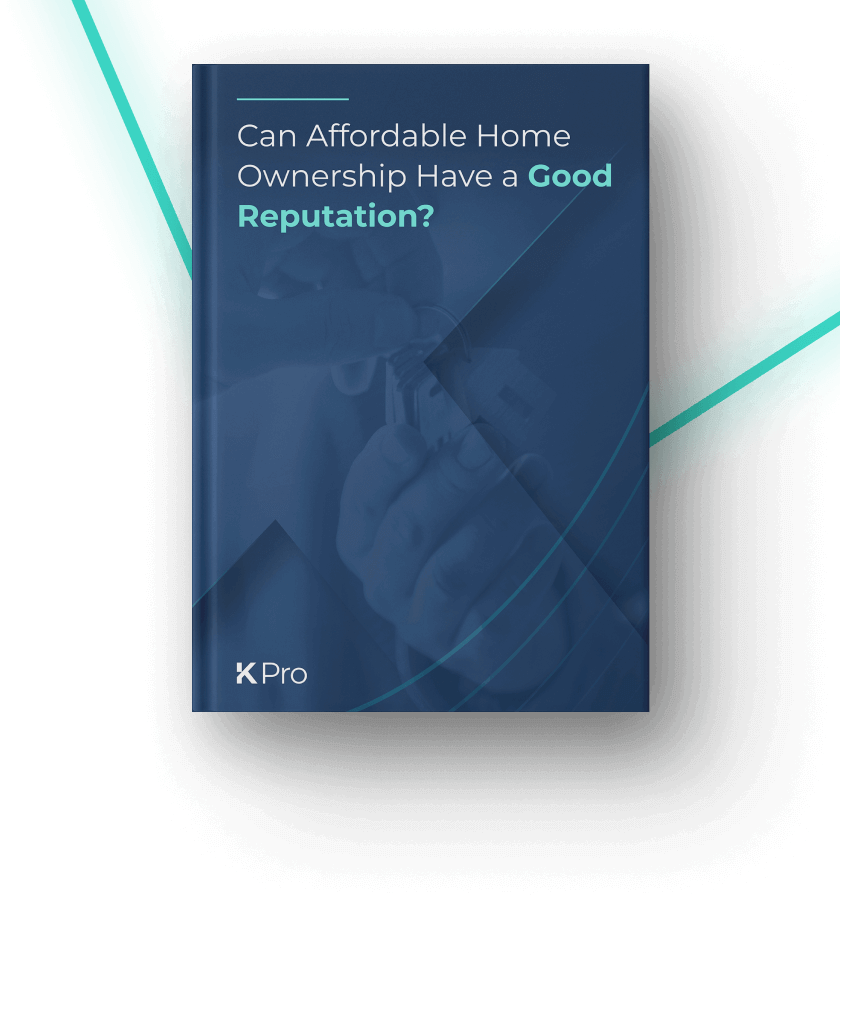
What the New Shared Ownership Model Means for Housing Providers
The revamped shared ownership scheme, announced in 2020, aims to make shared ownership more attractive, primarily by making it more affordable. Overall, the changes fulfil this aim. Alongside the attractive new model, the popular Help to Buy scheme is ending, presenting housing providers with an opportunity – which they can seize by embracing new technology.
As customers look towards the new model and away from Help to Buy, housing providers need to be prepared for a potential increase in demand – not least because shared ownership is also their main revenue generator.1
Preparedness means embracing the digital changes taking place across the industry, specifically in marketing, sales and letting processes. By doing this, there are opportunities for providers to lead the industry.
In this article, we’ll explain the changes in the new shared ownership model, what they mean for providers and tenants, and how providers can take advantage of the opportunity the new model provides.

Changes to shared ownership
The changes to shared ownership represent the biggest change to the scheme’s model so far. The changes only apply to properties that received planning permission after April 2021.2The key changes are:
1. Lower minimum shares
Buyers can now purchase a minimum initial purchase share of 10% of a property, down from 25%. This means smaller deposits, reducing the barrier to home ownership.
However, the rent on the remaining share might rise, and steeply. The model lease proposed by Home England allows for a rent increase of Retail Price Index (representing inflation) plus 0.5%.3
For providers, a lower minimum share purchase opens the door to more potential customers. Providers need to be ready to support a greater number of leads. This means effective lead management and improved outreach — an area where the industry has not typically excelled.
2. 1% staircasing increments for the first 15 years
Minimum staircasing increments have been lowered from 10% to 1%. Previously, owners could only increase their additional shares by 10% or more at a given time. The new model allows 1% increments for the first 15 years, making it easier and more affordable to gradually own more property.
This change doesn’t increase owners’ ability to own the property more quickly. This change will not directly impact the speed at which providers will need to increase their housing stock. Providers will need to include the new staircasing information in listing information, updating these listings across all sites.
3. Reduced nomination period
The nominations period has been reduced from eight weeks to four weeks. This is where housing associations and providers have exclusive rights to remarket the property before owners take over the sales process.
The eight-week period still exists in the new model, but shared owners can choose to end it after only four weeks. At which point, they take over the sales process..
The change gives homeowners more control over the resale process. For providers, the shorter nominations period increases the need for effective marketing, sales and lettings processes, to be able to remarket the property efficiently.
4. Increased repair and maintenance contributions from housing providers
Housing associations will have to contribute to ‘essential’ repairs and maintenance costs during the first 10 years — up to £500.
Shared owners roll over up to one year’s worth of unused expenditure into the following year. Any repair or maintenance costs over this amount are paid by the owner.
Under the change, providers will have to fork out more for repair and maintenance. Overall, however, this makes the scheme more attractive to potential customers, increasing interest in the scheme. Providers will need to ensure they have clear communication with owners around repairs and maintenance. Providers will also need effective methods of logging requests and completions.
5. Longer lease length
The shared ownership lease length has been increased to 990 years from 125. This removes the need for a lease extension, which can be very costly for shared owners.
However, this could also make homes with 99 or 125-year leases, which comprises the majority of existing shared ownership properties, less attractive to prospective buyers. This might create a split market between properties with more attractive longer leases, and those with the old shorter leases.
Providers will need to keep on top of the lease length information across all their property listings. Making sure this information is correct is vital to providing accurate property information to potential customers.
6. Further changes
The new model brings in further changes, including::
- Providers must provide a key information document pack with the memorandum of sale, rather than within the lease.
- Providers must also notify leaseholders of the current value of their property on an annual basis.
- A Right to Shared Ownership. This gives tenants in eligible social housing properties the right to purchase their homes under shared ownership terms.
Take away the pressure of new changes with fewer tools that work well together.
Unify your sales and lettings process.
What does the new model mean for housing providers?
Increased demand
- The changes to the model make shared ownership a more attractive proposition for potential buyers. Providers can seize on enhanced interest, the potential increase in demand, and the benefits this provides. To do this, providers will need effective marketing strategies and efficient internal processes.
- With Help to Buy ending in March 2023, current and future demand for that scheme might be redirected towards shared ownership. Taken with the changes, shared ownership might seem like Help to Buy’s natural successor – if providers can successfully market the scheme.
Revenue and reinvestment
As the main revenue generator for housing associations, any increase in the attractiveness of — and demand for — shared ownership increases the chance of further revenue. More revenue means more reinvestment, internally and across the wider market.
But improvements are needed
- Providers need to be ready to deal with new leads that might come their way. This means automated processes, centralised lead management, and an integrated tech stack and CRM. Processes need to run smoothly, from lead generation to helping tenants in properties.
- Listing information will need to be updated based on the new changes. This means changing and updating complex listing information across all listings, across all listing sites.
- Providers will also need to deal with increased repair and maintenance requests, logging and fulfilling requests timely and accurately.
How housing providers can capitalise on the changes
The changes provide a big opportunity for housing providers — but only if they can take advantage of it.
The affordable housing market is rapidly modernising. The Government’s whitepaper on Planning for the future is enhancing and digitising the planning process. Meanwhile, software designed specifically for the affordable housing market is transforming the marketing, sales and lettings processes.
Slow and outdated tools create a bottleneck between gaining leads and converting them. Customer experience suffers. If potential Help to Buy customers look to shared ownership and the tools aren’t up to standard, they’ll look elsewhere.
But new tools are designed for efficient processes. They enable providers and customers to easily navigate the complexities of shared ownership — from staircasing requirements to complex listing information. These tools include:
1. Centralised lead collection
Centralise all the leads you collect on different platforms and manage them in one place. This enables you to store and access the information with ease, map out your leads’ customer journey, and improve communication.
2. One-click listings
List properties on multiple platforms from a centralised location and update your listings across different platforms at the same time. One-click listings eliminate the hassle of updating your listings – with complex requirements – manually, site by site.
3. Automation and personalisation
Automating marketing processes based on leads’ specific information saves time, allowing resources to be deployed elsewhere. Personalising the process through information taken from the centralised lead database improves customer experience, and provides them with the right information at the right time.
4. Provide self-service information
Customer self-service portals help owners, once in the property, take control of their journey and feel empowered. These tools should help:
- Prospective customers to keep track of property viewings and appointments, save their favourite listings, view documentation and requirements, and carry out ID verifications.
- Bring shared ownership in line with customer expectations by improving their experience and simplifying the entire process.

Using tools built for housing providers
Changes that encourage people into affordable housing schemes are positive changes for providers. The new model provides prospective homeowners with a new, more affordable, chance to get on the property ladder.
And it gives housing providers a greater opportunity to provide for them. But this won’t happen by itself. Only by getting the digital transition right can providers seize the opportunity and lead the industry.
KPro’s software was designed with and for housing providers. It brings the marketing, sales and letting capabilities of the commercial market to the affordable market.
KPro’s tools allow you to add and update listings across all listing sites simultaneously. It centralises leads, automates marketing processes and provides self-service tools to tenants to give them greater control over their home ownership. It can be delivered end-to-end or as a modular solution to work alongside your existing tech stack.
Get in touch today and discover how you can improve your sales and lettings process with KPro.
About The Author
Computer science graduate with over 15 years of housing experience. Leading sales, marketing, research and development teams, and strategies, at G15 organisations such as L&Q and Southern Housing Group.







